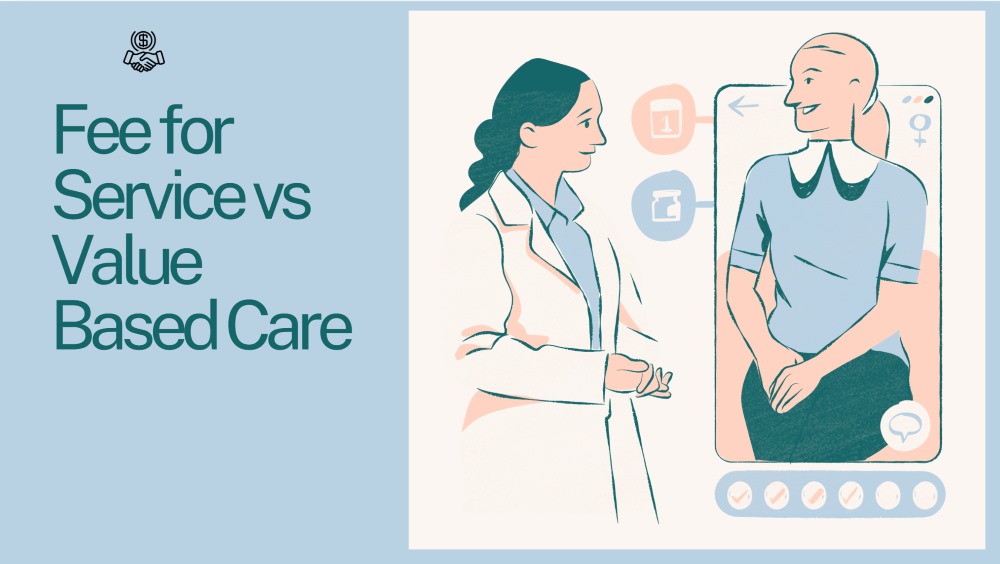Table of Contents
You have probably heard of fee for service vs value based care if your healthcare organization collaborates with several insurance companies. Given the trend in Medicare and Medicaid toward value-based care models, you may already be reviewing them. Comprehending the distinctions between these two models is essential for patients and healthcare practitioners alike.
You need to be aware of these models as a healthcare provider in order to reimburse services. Every model has certain requirements for figuring out how much to pay you for your services and is designed to achieve particular patient outcomes. To ensure you receive the correct payments, educate yourself on each model’s features and comparisons. The switch from fee-for-service to value-based care is not without difficulties, though, and each model has advantages and disadvantages that should be carefully weighed.
Fee for service (FFS) and how it works?
For a long time, the FFS model has dominated the American healthcare system. Its disregard for the effectiveness of treatment and patient outcomes, however, has drawn criticism. The conventional healthcare approach is fee-for-service (FFS). Each service is invoiced and paid for separately when using this paradigm by Medicare, Medicaid, and insurance companies. Because your payment is based on the number of services you give, this creates an incentive for your agency to offer more services. For instance, you receive separate payment for office visits, tests, procedures, and treatments under the fee-for-service approach.
You file claims for every treatment you deliver, and the insurance company reimburses you separately, if your patient’s provider uses the FFS model for reimbursement. Regardless of the patient’s result, you get reimbursed under this arrangement. Even though FFS makes it more difficult to coordinate care across many providers, this paradigm is more straightforward and adaptable. Critics claim that rather than emphasizing the entire health and well-being of the patient, the FFS model encourages physicians to carry out more treatments.
Value Based Care (VBC) and how it works?
Value-based care is different from the standard Fee-For-Service (FFS) model in that it emphasizes the quality of care and outcomes while discouraging healthcare providers to deliver more services regardless of the outcome. VBC prioritizes the patient experience and the caliber of your care. Value-based care inspires you to improve the patient experience rather than pressuring your organization to offer more services per patient. You provide the patient with holistic treatment while using the value-based care paradigm. You are motivated to work with other service providers because your compensation is dependent on the successful treatment of your patients. Knowledge of value-based care is essential because CMS is pushing for a greater use of it in facilities.
For example, under the FFS model, you are more likely to provide all of these services in-house while treating a patient with a complex ailment who requires numerous diagnostic tests, medication, physical therapy, and other therapies. On the other hand, value-based care necessitates quality, thus in order to enhance therapy, you will probably put together a thorough team of experts. By 2030, the Centers for Medicare and Medicaid Services (CMS) wants all Medicare beneficiaries to be connected to quality or value. But as of 2024, Medicare payments are still based on a fee-for-service model.
This model allows you to submit an episode-based charge that includes all services provided during treatment, or you can submit a bundled medical bill. You can submit many caregivers’ services on one bill if you are organizing their services together. Value-based care also highlights the significance of population health management and care management. This means that instead of only treating specific individuals, healthcare providers are also accountable for maintaining the health of the population they serve.
Fee for Service vs Value Based Care
The shift from FFS to VBC is not always simple, as it necessitates considerable changes in how healthcare is delivered and paid for. You will still encounter the fee-for-service model in your practice even though a lot of insurance carriers are switching to a value-based care model. These two models differ in the following important ways.
Patient Outcomes and Quality of Care
You run the risk of over servicing a patient when using the fee-for-service model since it places more emphasis on the services you offer than patient outcomes. Providing a patient with various services may result in higher out-of-pocket costs for them as well as financial strain on insurance companies.
Furthermore, your payment is independent on each patient’s outcome. In the event that a therapy does not work, you can always try another provider. Value-based care may motivate you to concentrate more on preventative care and other services that assist your patients in managing their conditions since it links your reimbursement to patient happiness and the quality of the care you provide.
Financial Risk and Reimbursement
Value-based care is often less risky than the fee-for-service approach. As a result of receiving recognition for your superior patient care, you are motivated to achieve favorable patient outcomes. Offering more preventive treatment will also encourage you to keep patients well and out of the hospital. With an incentive to maintain patients’ health and avoid expensive operations and hospital stays, this model also lowers the financial risk for providers.
Costs of Healthcare
Value-based care models prioritize prevention, which could result in lower medical expenses for your patients. Together, you and your patients seek to address lifestyle modifications and other factors that a patient can manage to lower their risk of requiring costly tests, surgeries, medication, and other procedures. VBC encourages healthcare professionals to focus on providing high-quality treatment, which can result in financial rewards and shared savings.
Transitioning to Value-Based Healthcare
You have to adapt to the Centers for Medicare and Medicaid Services and other major providers as they move toward value-based care models. Learn to evaluate your patients who pose the greatest danger as you begin to think about the change.
Examine your existing patient list to determine who is most likely to require costly medical procedures. Those with many comorbidities, which increase their susceptibility to disease consequences, are among these individuals.
Examine the other socioeconomic determinants of health in your community as well, such as the causes of high medical expenses. Create plans for managing your high-risk patients’ care economically after you have evaluated them. Look for local partners who can assist with treatment.
Promote Wellbeing
Many patients eligible for free or significantly reduced annual wellness tests and physicals, depending on their insurance carrier. Urge your patients to get yearly physicals so that possible health issues can be identified early on. Use your patient management system to automatically notify patients who are past due for a physical examination, if you have not already. VBC can also have an adverse effect in that healthcare professionals may be penalized for inadequate outcomes for patients or failing to fulfill quality measures.
Pay Attention to the Patient Experience
Although you have put a lot of effort into developing a trustworthy bond with your patients, you ought to learn about their experiences as well. Therefore, consider the length of time patients typically spend with their practitioners as well as the length of their wait times.
Moreover, examine additional elements that enhance the patient experience, such as simple scheduling, the opportunity for patients to ask concerns prior to the appointment, and accurate billing. You can get input by giving out comment cards or surveying your current patient base. Enumerate possible enhancements and devise plans to put them into action. In order to thrive in a value-based healthcare system, providers must prioritize quality metrics such as patient happiness, clinical outcomes, and cost-effectiveness.
Let MD Compliance Solutions to Guide You Through Value-Based Healthcare
You need to step in to familiarize with new codes and the procedures involved in submitting claims because the value-based care payment model prioritizes quality. The Centers for Medicare and Medicaid Services (CMS) has played a crucial role in this transformation, with the Affordable Care Act (ACA) and subsequent legislation pushing value-based payment schemes.
The Triple Aim for enhancing the patient experience, boosting population health, and lowering costs has also been a driving force behind this transition. Alternatively, let MD Compliance Solutions help you with the procedure. Our team of medical billing experts has extensive experience in practice administration and medical billing.
Our team members are professionals who keep up to date on the latest advancements in medical billing, such as value-based care. We can identify claim issues with our 100% cloud-based solution before you submit them, allowing you to ensure that every claim is accurate. We know how to collaborate with various providers for coordinated claims, and we keep up with the latest requirements. Read More: What is Coordination of Benefits (COB)?


